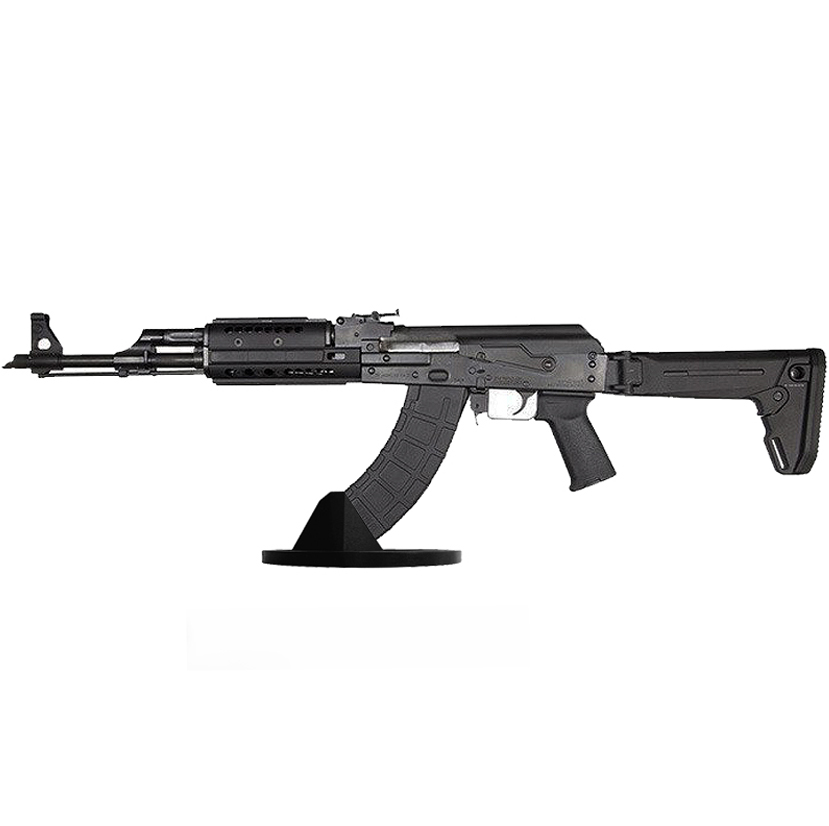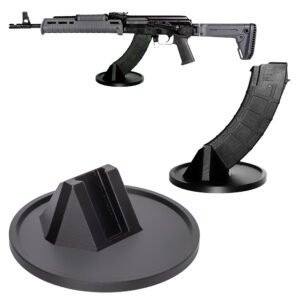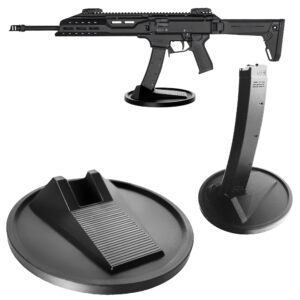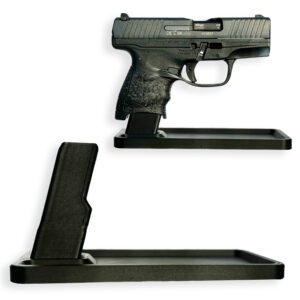
Categories:
The AK-47, officially known as the Avtomat Kalashnikova 1947, is an assault rifle that has left an indelible mark on modern warfare and armed conflict. Its development began in the aftermath of World War II, a time when the Soviet Union sought to enhance its military capabilities with more efficient and reliable weaponry. The brainchild behind this iconic gun was Mikhail Kalashnikov, a Soviet engineer and lieutenant general who combined his wartime experiences with engineering expertise to design a weapon that would meet the Red Army’s demanding requirements.
Introduced in 1947, the AK-47 was developed during a period of intense military innovation. The Soviets were keenly aware of the limitations posed by their existing weapons and aimed to create a gun that could offer both firepower and durability under harsh conditions. The rifle’s design drew upon various elements from earlier guns but incorporated several unique features that set it apart.
Its gas-operated mechanism allowed for automatic firing while maintaining simplicity in construction, which made it easier to produce en masse.
One key factor contributing to its widespread use is its remarkable reliability. During testing phases, the AK-47 demonstrated unparalleled resilience in extreme environments—whether exposed to mud, sand, or freezing temperatures. This robustness made it particularly appealing not only to Soviet forces but also to other nations seeking dependable weaponry for diverse climates.
The geopolitical landscape of the Cold War further facilitated its proliferation. As part of their strategy to spread influence across continents, the Soviet Union distributed millions of AK-47s—and later variants—to allied states and revolutionary movements around the world. This distribution network ensured that by the late 20th century, there were few conflict zones where one wouldn’t encounter this ubiquitous gun.
Thus, from its conception rooted in post-war exigencies to becoming a global symbol of insurgency and state power alike, the AK-47’s historical development encapsulates both technological ingenuity and strategic dissemination on an unprecedented scale.
The AK-47, or Kalashnikov, has garnered a reputation for its remarkable design and durability, factors that have significantly contributed to its widespread use in armed forces around the world. Designed by Mikhail Kalashnikov in 1947, this assault rifle was engineered with simplicity and robustness in mind—qualities that make it exceptionally reliable in various conditions.
One of the key elements of the AK-47’s design is its simplicity. The rifle has fewer moving parts compared to many other guns, which reduces the likelihood of mechanical failure. This straightforward construction not only makes it easier to manufacture but also simplifies training for soldiers who may not have extensive technical backgrounds. The ease of disassembly and reassembly ensures that maintenance can be conducted quickly and efficiently, even under challenging field conditions.
The durability of the AK-47 is legendary. It was designed to withstand harsh environments—ranging from arid deserts to humid jungles—without compromising functionality. The rifle’s components are made from high-quality steel and wood, materials chosen for their resilience against wear and tear as well as extreme temperatures. Additionally, the loose tolerances between moving parts allow dirt, sand, or mud to pass through without jamming the weapon.
This feature is particularly advantageous in combat scenarios where guns often face exposure to adverse elements.
Another aspect contributing to its enduring popularity is its reliable performance under strenuous conditions. Unlike many other rifles that require frequent cleaning and meticulous care to function correctly, the AK-47 can continue operating effectively even when neglected. This reliability has earned it trust among soldiers who need a weapon they can depend on without constant maintenance.
Moreover, its design facilitates mass production at a low cost—a crucial factor for many nations’ military budgets. The combination of these attributes—simplicity in design, exceptional durability, reliable performance under adverse conditions, and cost-effective production—has solidified the AK-47’s position as a staple gun in armed forces worldwide.
In summary, the AK-47’s esteemed status owes much to its intelligently engineered design and unparalleled durability. These characteristics ensure that it remains an indispensable tool for soldiers globally across diverse terrains and challenging operational environments.
The ease of use and training associated with the AK-47 has significantly contributed to its widespread adoption among the world’s armed forces. Designed by Mikhail Kalashnikov in 1947, the AK-47 was engineered with simplicity in mind, making it an ideal choice for soldiers of varying skill levels and educational backgrounds. Its design allows for intuitive operation, which is essential in high-stress combat scenarios where quick decision-making and reliability are paramount.
One of the most notable features of the AK-47 is its straightforward mechanism. The rifle operates on a gas-powered system with a rotating bolt, which is relatively simple compared to more complex guns. This simplicity translates into fewer moving parts that could potentially malfunction or require intricate maintenance. Soldiers can quickly learn how to disassemble and reassemble the weapon, an essential skill for cleaning and field repairs.
This ease of maintenance ensures that even those with minimal technical knowledge can keep their weapons operational under adverse conditions.
Furthermore, the AK-47’s rugged construction makes it incredibly forgiving when it comes to handling errors or environmental challenges. It can function reliably in extreme temperatures, muddy terrains, and sandy environments without significant degradation in performance. This robustness reduces the need for extensive training on how to handle different environmental factors affecting gun functionality.
Training programs for new recruits often have limited timeframes; thus, a weapon that requires minimal instruction time is invaluable. The learning curve associated with mastering the AK-47 is relatively short compared to other assault rifles like the M16 or G36. Basic marksmanship can be achieved quickly due to its manageable recoil and user-friendly iron sights.
Moreover, this ease of use extends beyond formal military settings; non-state actors and militias also find value in a weapon that does not necessitate extensive training infrastructure. Consequently, this versatility has cemented the AK-47’s status as one of history’s most ubiquitous guns.
In summary, the AK-47’s design philosophy prioritizes simplicity and durability over complexity and finesse. These characteristics ensure that soldiers can become proficient users with minimal training while maintaining operational effectiveness across diverse environments—a combination that has made it an enduring fixture in armed forces worldwide.
One of the primary reasons for the extensive global use of the AK-47 in armed forces is its remarkable cost-effectiveness. This assault rifle, designed by Mikhail Kalashnikov in 1947, has become synonymous with affordability and efficiency, making it a favored choice for both state and non-state actors around the world.
The production costs of the AK-47 are relatively low compared to other modern guns. This is largely due to its simplified design and manufacturing process. The rifle’s components can be produced using less sophisticated machinery and lower-grade materials without significantly compromising its functionality or durability. This ease of production has led to widespread manufacturing capabilities across different countries, further driving down costs due to economies of scale.
Additionally, the AK-47’s longevity contributes significantly to its cost-effectiveness. Known for its ruggedness and reliability under harsh conditions, this gun requires minimal maintenance. It can function effectively in diverse environments—ranging from arid deserts to humid jungles—without frequent repairs or replacement parts. This reduces long-term operational costs for military forces that might otherwise spend significant resources on maintaining more delicate weaponry.
The availability of ammunition is another crucial factor enhancing the AK-47’s cost-effectiveness. The 7.62x39mm rounds used by this rifle are among the most widely produced ammunition types globally, ensuring a steady supply at relatively low prices. Bulk production and widespread availability mean that armed forces do not face exorbitant expenses when procuring ammunition, which is an ongoing logistical consideration during extended conflicts.
Moreover, training soldiers to use the AK-47 effectively does not require extensive resources or time due to its straightforward design and user-friendly operation. With fewer technical complexities involved in handling and maintenance, military units can achieve operational readiness more swiftly compared to other advanced weapon systems that demand rigorous training programs.
In summary, the AK-47’s cost-effectiveness stems from its low production costs, durability under adverse conditions, affordable ammunition supply, and ease of training soldiers in its use—all critical factors that contribute to its pervasive presence in global armed forces.
The AK-47’s widespread adoption across the globe can be significantly attributed to its unparalleled reliability in a variety of conditions. Designed by Mikhail Kalashnikov and first introduced in 1947, this assault rifle has proven itself time and again as an exceptionally durable weapon, capable of maintaining functionality under conditions that would render many other guns inoperable.
One of the key aspects contributing to the AK-47’s reliability is its simple yet robust design. The rifle features fewer moving parts compared to many modern guns, which reduces the likelihood of mechanical failure. This simplicity extends to its gas-operated mechanism, which is less prone to jamming due to dirt or debris. The loose tolerances between moving parts further ensure that the rifle can continue operating even when subjected to significant amounts of mud, sand, or snow—conditions commonly encountered in various combat zones around the world.
Another critical factor is its construction from materials specifically chosen for their durability and resistance to wear and tear. The AK-47’s receiver is made from stamped steel rather than milled steel or aluminum alloys found in other rifles. This makes it more resistant to bending and breaking under stress. Additionally, its wooden stock and handguard are not only rugged but also easier and cheaper to replace compared to synthetic alternatives.
Moreover, field maintenance of the AK-47 requires minimal effort and technical knowledge. Soldiers can disassemble and reassemble the weapon quickly without specialized tools, making it easier for troops with limited training or resources to keep their rifles operational. This aspect is particularly advantageous in insurgent groups or poorly funded military forces where access to advanced maintenance facilities might be limited.
The ability of the AK-47 to perform reliably across diverse climates—from scorching deserts and humid jungles to freezing tundras—has cemented its reputation as a versatile tool for armed forces worldwide. Its resilience ensures that soldiers can depend on their weapon regardless of environmental challenges they may face, thereby enhancing combat effectiveness. This combination of simplicity, durability, and ease of maintenance underscores why the AK-47 continues to be a mainstay in global arsenals over seven decades after its inception.
The global distribution and availability of the AK-47 are key factors in its widespread use among the world’s armed forces. Originally designed by Mikhail Kalashnikov in the Soviet Union during the late 1940s, the AK-47 quickly became a symbol of Soviet military power and ideological influence. The USSR’s strategy of arming allied nations and insurgent groups during the Cold War era played a significant role in disseminating this gun across various continents.
One of the primary reasons for its extensive distribution is its robust design and ease of manufacture. The simplicity of the AK-47’s construction allows for mass production using relatively unsophisticated machinery, making it accessible to both state and non-state actors. As a result, many countries with limited industrial capabilities have been able to produce or assemble their own versions of this rifle.
Over time, numerous variants have emerged from different manufacturers around the world, each adapting to local conditions but retaining core characteristics that make them identifiable as part of the AK family.
The proliferation was further enhanced by geopolitical dynamics. During conflicts such as those in Vietnam, Afghanistan, Africa, and Latin America, both superpowers—the United States and Soviet Union—supplied their respective allies with vast quantities of arms. The Soviets provided millions of AK-47s to communist regimes and liberation movements globally, embedding these weapons deeply into regional conflicts.
Following the dissolution of the Soviet Union in 1991, large stockpiles of surplus weapons flooded international markets at bargain prices. These guns often found their way into conflict zones where they were sold or traded with little oversight. This post-Cold War influx ensured that even decades later, AK-47s remain readily available on both legal arms markets and black markets worldwide.
Furthermore, international arms trade agreements have not effectively curtailed their spread due to inconsistent enforcement across different jurisdictions. Consequently, today’s armed forces—ranging from formal national militaries to irregular militias—continue to rely on this ubiquitous weapon due to its availability coupled with a reputation for durability under harsh conditions.
In essence, historical geopolitical strategies combined with economic factors have ensured that the AK-47 remains one of the most widely distributed guns globally—a testament to its enduring legacy as a weapon designed for accessibility and reliability.
The AK-47’s widespread use in global armed forces can be attributed not only to its technical merits but also to its profound cultural and symbolic significance. This weapon has transcended its role as a mere tool of warfare to become an emblem of revolution, resistance, and resilience.
From the jungles of Vietnam to the deserts of Africa, the AK-47 is instantly recognizable, often becoming a potent symbol in various socio-political contexts. Its silhouette is emblazoned on flags, murals, and propaganda posters around the world. The rifle embodies a spirit of defiance against colonialism and oppression; it has been wielded by liberation movements that sought to overthrow oppressive regimes and colonial powers.
In this way, the AK-47 has become synonymous with the fight for autonomy and self-determination.
Moreover, its presence in popular culture further cements its iconic status. Films, literature, music videos, and video games frequently depict the AK-47 as an instrument of both rebellion and survival. This widespread representation reinforces its image as a reliable companion in dire circumstances—a weapon for those who must make do with limited resources yet face overwhelming odds.
In many regions plagued by conflict or instability, possessing an AK-47 carries significant social capital. It symbolizes power and control in environments where formal structures have collapsed or are ineffective. For some groups or individuals within these societies, owning an AK-47 can be a matter of identity or prestige.
Additionally, the simplicity and durability of the rifle feed into narratives about ingenuity and practicality—values highly esteemed in cultures facing continuous hardship. The fact that it can be easily maintained with minimal expertise adds to its allure among guerilla fighters who must operate independently from formal military infrastructure.
Thus, beyond being just an efficient gun, the AK-47 holds deep cultural resonance across diverse communities worldwide. It stands as both a practical instrument of war and a powerful symbol imbued with layers of historical significance—an icon that continues to shape perceptions long after battles have ended.








Colt
Colt M4 Carbine
Colt LE6920
Colt AR-15 A4
Daniel Defense
DDM4 V7
DDM4 V9
DDM4 V11
DDM4 ISR (Integrally Suppressed Rifle)
Smith & Wesson (S&W)
M&P15 Sport II
M&P15 Tactical
M&P15T
Bravo Company Manufacturing (BCM)
BCM Recce-16
BCM Recce-14
BCM MCMR Series
Aero Precision
M4E1 Series
AC-15
AR15 Pistol (Various Configurations)
Ruger
Ruger AR-556
Ruger SR-556
Ruger AR-556 MPR (Multi-Purpose Rifle)
Springfield Armory
Saint Victor
Saint Edge
Saint AR-15
PSA (Palmetto State Armory)
PSA PA-15
PSA AR-V
PSA Jakl (AR Pistol)
FN America
FN 15 Tactical Carbine
FN 15 Patrol
FN 15 DMR
Wilson Combat
Recon Tactical
Super Sniper
Protector Carbine
SIG Sauer
SIG M400 Tread
SIG M400 Elite
SIG M400 SDI
LWRC International
IC DI (Direct Impingement)
IC SPR
IC A5
Bushmaster Guns
XM-15 QRC
Bushmaster MOE
XM-15 Patrolman
Rock River Arms
LAR-15 Entry Tactical
LAR-15 Predator
LAR-15 Elite Comp
Stag Arms
Stag 15 Tactical
Stag 15L (Left-Handed Models)
Stag 15 Valkyrie
Noveske Rifleworks
Noveske Gen 4 N4
Noveske Space Invader (AR Pistol)
Noveske Recon
Anderson Manufacturing
AM-15 Optic Ready
AM-15 M4 Carbine
AM-15 Precision Rifle
Adams Arms
AA-15 Piston Rifle
P2 AARS (Adams Arms Rifle Series)
Black Rain Ordnance
SPEC15 Series
BRO Predator
Fallout 15
Diamondback Guns
DB15 Series
DB15CCMLB
DB15EB
Del-Ton Inc.
DTI-15
Del-Ton Echo 316H
Sierra 316M
Windham Weaponry
Windham SRC
Windham VEX-SS
Windham RMCS-4 (Caliber Conversion System)
Christensen Arms
CA-15 G2
CA-15 Recon
CA-15 Titanium Edition
Patriot Ordnance Factory (POF-USA)
Renegade Plus
P415 Edge
Revolution DI
LaRue Tactical
PredatAR
OBR (Optimized Battle Rifle)
LaRue Stealth 2.0
Battle Arms Development
Workhorse Patrol Carbine
BAD556-LW (Lightweight)
Authority Elite Rifle
Faxon Guns
Ascent AR-15
FX-19 (AR Pistol)
Streamline Ultralight Series
KE Arms
KE-15 SLT (Super Lightweight Tactical)
KE-15 Scout Carbine
Primary Weapons Systems (PWS)
MK1 MOD 2-M
MK116 PRO
MK107 (Piston AR Pistol)
ZEV Technologies
ZEV Core Elite Rifle
ZEV AR15 Billet Rifles
Franklin Armory
BFSIII AR-C1
Militia Model
F17-L (Chambered in .17 WSM)
Seekins Precision
SP15 DMR
NX15 Skeletonized Rifle
Havak Bravo
Aero Precision (Additional Models)
EPC-9 (Pistol Caliber ARs)
VG6 AR Rifles
Barrett Guns
REC7 DI
REC7 Gen II
CMMG
MK4 RCE
Resolute 300
Banshee (AR Pistol)
DPMS Panther Arms
Panther Oracle
Panther LR-308
H&K (Heckler & Koch)
HK MR556A1
HK416 (Military Variant)
Rock Island Armory (Armscor)
VR-80 Tactical AR (Shotgun AR Platform)
Troy Industries
Troy SPC-A3
Troy PAR (Pump Action AR)
Wilson Tactical
Tactical Recon AR
Protector Series
F1 Guns
FDR-15 Skeletonized Rifle
BDRx-15 Series
Juggernaut Tactical
JT-15
JT-10 Precision Rifle
AeroSurplus
Surplus AR-15 Rifles (Budget Models)
Thunder Tactical
AR-15 Basic Carbine
Tactical Builder Sets
Radical Guns
RF-15
Forged AR-Series
Dark Storm Industries
DS-15 Featureless Rifles
DS-10 Typhoon
DRD Tactical
Paratus
Aptus AR Rifles
Bear Creek Arsenal
BCA-15
AR Complete Upper Builds
Aero Survival Rifles (ASI)
ASR Tactical Series
Tactical Edge
WARFIGHTER Series
AR-15 Lightweight Rifles
Lone Star Armory
TX15 DMR
TX15 Carbine
HERA Arms
HERA H7
HERA AR-15 Lower Builds
IWI (Israeli Weapon Industries)
Zion-15
DRD Tactical
Tactical Modular Rifles
Quick-Takedown Rifles
V Seven Weapons
1776 Rifle
Hyperlite Rifle
Core Rifle Systems
Core15 Tac III
Core15 Patrol Rifle
Armalite (Original AR-15 Creator)
M15 Tactical
M15 A4 Carbine
DEF15 (Defensive Sporting Rifle Series)
PSA (Palmetto State Armory Additional Models)
PSAK-47 Hybrid (AR-AK Style Hybrid)
PSA Dagger (Pistol Caliber Configurations)
Odin Works
OTR-15
Odin Recon Rifle
Maxim Defense
MDX-508 PDX (Compact AR Pistol)
MDX-510 Rifle